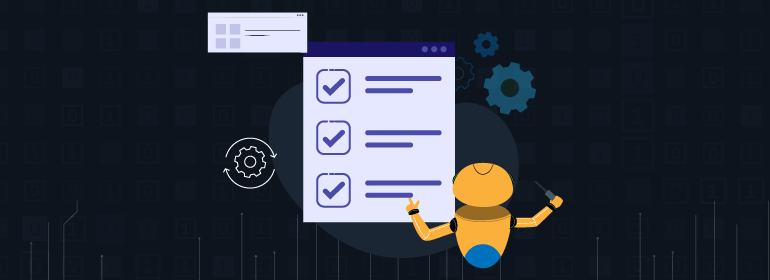Gain unprecedented monitoring visibility with AIOps

What is AIOps in monitoring?
AIOps (artificial intelligence in IT operations) in monitoring refers to the convergence of artificial intelligence, machine learning, and data analytics to make IT monitoring a responsive, intelligent, and agile business function. AIOps is not an alternative to DevOps but a great partner to it that provides intelligent insights when integrated with every stage of the cycle.
AIOps distills actionable insights from large pools of monitoring data drawn from different IT applications to view them holistically, systematically, and proactively. AIOps enables business owners to gain operational insights across different layers of the IT infrastructure, i.e., hybrid clouds, microservices, virtual machines, and containers, in a distributed architecture connected by a flurry of APIs.
Why AIOps in monitoring?
The IT world has shifted from an on-premises-heavy monolith IT infrastructure model to a dynamically scalable and flexible world of microservices and hybrid cloud deployments. While traditionally, monitoring was a piecemeal approach tied to the application, machine, or data level, today, monitoring is closely integrated with DevOps culture.
Also, a hybrid, multi-cloud architecture demands time and effort-saving automation for continuous monitoring with an in-depth correlation between observed metrics, logs, and traces across a complex IT landscape. With AIOps, IT teams can intelligently capture discrete monitoring data, make holistic sense of it, and implement changes to adjust the IT stack to factor in current trends.
With AIOps, DevOps teams can drastically reduce the mean time to repair (MTTR), cut data silos, make sense of scattered and diverse data pools, automate remediation, and gain unprecedented visibility into the tech stack with the least noise (meaningless and superfluous data that adds no value).
Site24x7 and AIOps
Site24x7's multivariate AI algorithms study multiple attributes in a monitor to spot anomalies dynamically, giving it richer context and purpose to base automation decisions. For agent-based monitors such as servers, IIS, or Hyper-V monitoring where multiple attributes correlate, Site24x7 adopts a combined approach that helps get more accurate predictions. For example, CPU usage, memory availability, disc reads, disc writes, and other related factors must be considered holistically to predict spikes or falls.
The difference that AIOps brings
Before AI, manual thresholds were set by studying previously polled data while also considering other configured poll strategies, if any, to set alerts. This manual approach was prone to gross errors, misjudgments, and misses because of variations in response time, including unpredicted weekend surges or outages along with the different hybrid cloud stacks. Also, since static thresholds are independent of historic data, there is a need to constantly revisit them to account for the changing behaviors of the monitor's metric. AI-based threshold profiles eliminate the need for manual changes when there is a genuine change in the metric's trend.
With AIOps in Site24x7 comes adaptability backed by constant learning that helps improve course correction by understanding the context first. Also, AIOps enables Site24x7 to analyze trends and factors in the likelihood of extreme fluctuations over a longer period of time. This helps avoid prematurely normalizing extreme events while simultaneously adapting to smaller spikes or falls—just as a human driver would adjust to a temporary stretch of a bumpy road, they are forced to hit the brakes when encountering large potholes or a broken bridge. For example, business applications that see a reduction in traffic on weekends are a recurrent, seasonal change that will be readily adapted by an anomaly engine.
Site24x7's AIOps: Intelligent and dynamic
While static models flag seemingly normal outages and, at the same time, fail to predict them in advance, Site24x7's AIOps studies the patterns to adjust the thresholds intelligently. As AI adapts to these normally expected changes, it spares IT teams from alert fatigue. On the other hand, intelligent and dynamic thresholds predicted by AI are better than hard-coding thresholds because such rigidity does not accommodate trends and acceptable fluctuations. Site24x7's AI also helps plot and predict emerging trends to nudge administrators to make room for surges.
With four weeks of training data to establish base values, AIOps in Site24x7 can begin its course, and with time, it gets better at detecting anomalies and setting appropriate thresholds. Site24x7 users can now forecast for various attributes, and these predictions are calculated based on trends and seasonality observed in the historical data. For example, our server monitor's disc capacity management provides an early warning for potential issues by forecasting next week's disk metrics, thereby helping to rebalance disk capacity proactively.
AIOps is offered as a standard part of many Site24x7 monitors, starting from anomaly detection to the events timeline and marking the service status. For incident management, Site24x7 also provides contextual, grouped, and correlated alerts that help reduce noise and avoid alert fatigue. Such intelligent alerts also help arrive at the root cause quickly and ultimately reduce the MTTR.
Site24x7's AI algorithms also study incident patterns to recognize oncoming incidents and alert the user proactively. Site24x7 constantly improves the efficacy of its anomaly algorithms to provide users with sharper insights.
Benefits of IT automation in AIOps
IT automation reduces the MTTR, an important service quality indicator, by ensuring instant rectifications based on learnings from AIOps. For example, an anomaly detected by AIOps in the monitoring system can be programmed to take automatic remediation actions like restarting a server, making a data backup, rebooting a service, or executing a certain script. Such actions instantly rectify the problem and instantly reflect in the status of the monitor coming back to normal. In large organizations running complex IT systems, such automatic interventions improve overall customer satisfaction.
Overall, AIOps empowers DevOps teams to forecast operational hurdles, flag anomalies, and proactively optimize spending. Implementing AIOps also assures lesser noise and more clarity in condensing actionable insights that help teams focus and act better and faster for the monitoring team, resulting in business benefits. While AIOps helps IT teams do more with less, human insight and judgment go hand-in-hand to derive the maximum benefit from these capabilities.